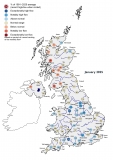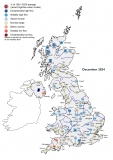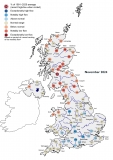Submitted by Lucy Barker on
February was a month of contrast in which unsettled, initially wintry conditions were followed by a dry period of unseasonable warmth. It was the second warmest February since 1910 for the UK (6.1°C), and new winter maxima, set at Trawsgoed on the 25th (20.6°C) and then at Kew Gardens a day later (21.2°C), both eclipsed the previous record by a wide margin. Rainfall totals were below average for the UK as a whole, compounding the dry January and resulting in a below average accumulation for the three winter months (78% of average). River flows were widely in the normal range, although above normal in Cumbria and below normal in the south and east, and notably below normal in the north east of England. Reservoir stocks increased, but Derwent Valley, Bradford Supply, Grafham and Roadford remained significantly below normal. Month-end Soil Moisture Deficits (SMDs) increased and were above average for England, Scotland and Northern Ireland. Groundwater levels generally ended February below normal, and were still receding at many boreholes. Notwithstanding healthy reservoir stocks and a wet start to March, further rain is needed over the next six weeks to counter long-term rainfall deficits and reduce the risk of pressure on water resources later in the year in large parts of England.



